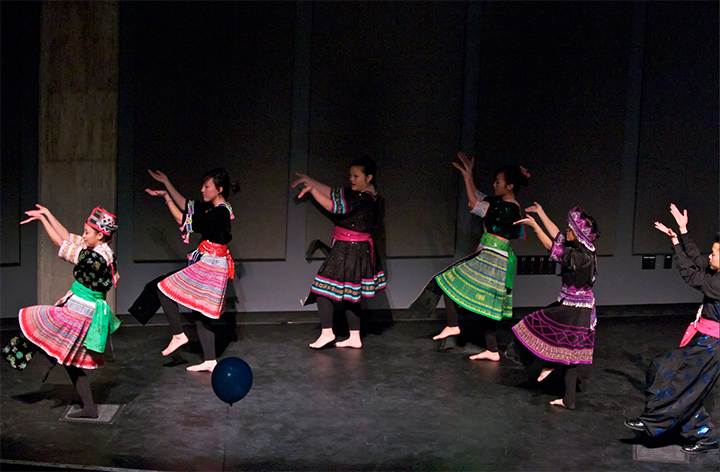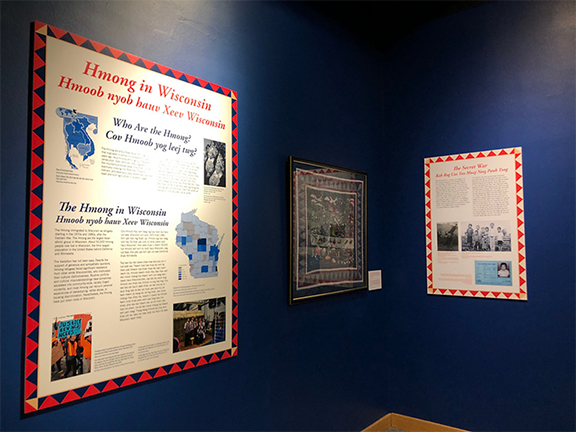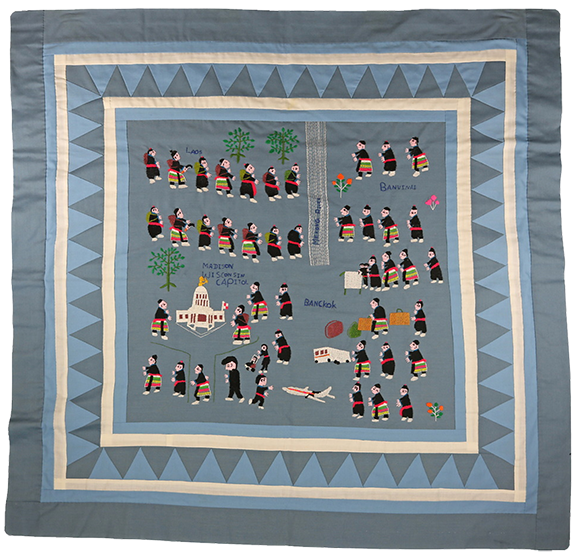The Wisconsin Historical Museum featured an exhibit called, “Hmong in Wisconsin.”
Credit: Wisconsin Historical Society (Usage Rights: Approved for print and digital for all audiences in perpetuity)
Grade: 6-9Subject:
U.S. History, Social Studies, English Language Arts
Number of Activities: 5 + Extensions
From 1964-1973, the U.S. Central Intelligence Agency (CIA) enlisted the HMong to participate in what is now known as the “Secret War” against communist forces in Vietnam and Laos. After the end of the Secret War in Southeast Asia, many HMong people in Laos faced persecution. As a result, thousands of HMong resettled in the United States. In this lesson, students will learn about their experiences resettling in Wisconsin. Students will examine how the HMong refugees build community and preserve cultural heritage.
Students will:
- Explain who the HMong people are.
- Describe the Secret War in Southeast Asia and the migration of HMong people to the United States.
- Summarize the resettlement experience of the HMong people in Wisconsin.
- Examine stories of HMong people living in Wisconsin.
HMong in Wisconsin Essay:
The HMong
The HMong are an ethnic group distinguished by their unique language and cultural heritage. They have a long history that dates back thousands of years. Early HMong people resided in China and had faced numerous wars and uprisings throughout the centuries. Beginning in the early 1800s, many HMong migrated to Vietnam, Laos, and Thailand. Maintaining their strong agricultural traditions, the HMong established villages in the highlands of Southeast Asia.
The HMong language in the United States is led by two main
dialects: White and Green. The White and Green distinction refers to the colors and patterns of the group's traditional clothing. White HMong women typically wear a white pleated skirt, while Green HMong women wear embroidered skirts with shades of green. Aside from clothing, the dialects also hold distinct cultural nuances. While both dialects share a common foundation, they have unique phonetic characteristics and vocabulary that distinguish them from one another. For example, the term “HMong” is spelled “Hmong/Hmoob” in the White dialect and “Mong/Moob” in the Green dialect. The spelling of “HMong” with capital “H” and “M” is made intentional in recognition of both the spoken and written Green and White HMong dialects.*
The HMong community is built on
oral traditions, a defining characteristic of their culture. Passing down knowledge, stories, and cultural practices through spoken word has been crucial in preserving their heritage and identity, especially in the face of
displacement and
diaspora. Their oral histories include a wide range of topics, from ancestry, folklore, historical events, and traditional practices.
The Secret War
In the 1960s, the U.S. Central Intelligence Agency (CIA) enlisted the HMong to participate in what is now known as the “Secret War” against
communist Vietnamese forces and the Pathet Lao. (“Pathet Lao” means “Lao Nation” or “Lao Country.”) The HMong undertook several crucial tasks under U.S. guidance, including disrupting communist activities and gathering intelligence. Following the conclusion of the Secret War in 1973, the HMong were targeted and persecuted by the victorious communist regimes. Following the U.S. withdrawal from Vietnam in 1975, thousands of HMong left Laos seeking
asylum in various European and Western countries, including Australia, France, Canada, Germany, and the United States.
Making Wisconsin Home
Because the HMong were political
refugees who left their country due to war and persecution, the U.S. government granted them legal admission to the country. Church organizations played a significant role in their
resettlement. Since 1975, the HMong community has made the United States home for many decades now. They live all across the United States, with large concentrations established in California, Minnesota, and Wisconsin.
The HMong culture, which is clan-oriented, deeply values family bonds. Throughout the years, the HMong population in Wisconsin has experienced steady growth. A key factor in this has been family
reunification. As HMong refugees settled in the state, they
sponsored the immigration of their relatives, resulting in further waves of newcomers. Many also relocated to Wisconsin even when they were assigned to resettle in other states. They were motivated by a desire to reunite with their families and relatives and/or be a part of a larger HMong community. Relocating to a new country and to Wisconsin, specifically, brought challenges for the HMong people, who found themselves navigating a vastly different environment and way of life. Not only were they learning English for the first time but also adapting to a climate that included a winter season. In addition, they were figuring out how to find jobs, build a community from scratch, and raise their families. All the while, they worked hard to preserve their traditional customs and practices.
As political refugees, many members of the HMong community were still coping with the
traumas of war and separation from loved ones. Moreover, the HMong people frequently encountered discrimination and
microaggressions. The refugees encountered many Americans who had little to no knowledge of their culture and histories, often leading to misunderstanding, suspicion, and hostility. This was particularly present in the aftermath of the war in Southeast Asia.
Today, the HMong community is an essential part of Wisconsin's cultural landscape and diversity, contributing to its economy. For example, HMong Americans are a significant part of the manufacturing industry in Wisconsin. Large numbers are also employed in educational services, healthcare and social assistance, and retail trade. In 2009, HMong American Pai Yang** opened Phongsavan Market Place in Milwaukee, a market building with over seventy shops and restaurants. The market also has a concert space and serves as a community gathering space. Phongsavan Market Place has created new jobs and attracted visitors to the area. (Note: The market was previously sold in 2020 but Yang regained ownership in 2023.)
HMong Americans have also engaged in Wisconsin’s political landscape. For example, Joe Bee Xiong (1961-2007) was the first HMong person in the United States elected to municipal government. He served two terms on the Eau Claire City Council. Kashoua Kristy Yang** is the country's first HMong elected judge. She is also the first Asian American elected judge in Wisconsin, and was elected to the Milwaukee County Circuit Court in 2017.
* In this essay, the spelling of HMong is written in order to reflect both the White and Green dialects.
** Life years unknown.
Bibliography:
Pfeifer, M. E., Chiu, M., & Yang, K. (Eds.). (2013). Diversity in Diaspora: Hmong Americans in the Twenty-First century. University of Hawai'i Press.
Vang, C. T. (2016). Hmong refugees in the New World: Culture, Community and Opportunity. McFarland & Company, Inc., Publishers.
Vang, C. Y. (2008). Hmong in Minnesota. Minnesota Historical Society Press.
Vang, C. Y. (2010). Hmong America: Reconstructing Community in Diaspora. University of Illinois Press.
Vang, M. (2021). History on the Run: Secrecy, Fugitivity, and Hmong refugee epistemologies. Duke University Press.
Vang, T. S. (2008). A History of the Hmong: From Ancient Times to the Modern Diaspora. Lulu Press.
Vue, M. Z. (2020). Hmong in Wisconsin. Wisconsin Historical Society Press.
- Asylum: protection given especially to political refugees
- Communism: a system in which goods are owned in common and are available to all as needed
- Dialect: a form of a language that differs from another language that is particular to a region or group
- Diaspora: the movement of any population sharing a common ethnic identity who were either forced to leave or voluntarily left their settled territory and became residents in areas often far removed from the former 2
- Displacement the state of being removed from the usual or proper place
- Intergenerational: existing or occurring between generations
- Microaggression: a comment or action that subtly and often unconsciously or unintentionally expresses a prejudiced attitude toward a member of a marginalized group
- Migration: the movement of a person or a group of persons, either across an international border, or within a state2
- Oral tradition: the stories, beliefs, etc., that a group of people share by telling stories and talking to each other
- Oral history: a field of study and a method of gathering, preserving and interpreting the voices and memories of people, communities, and participants in past events3
- Persecution: state of subjecting a person or group to hostility or punishment, especially because of their ethnicity, religion, or sexual orientation or political beliefs
- Phonetic: of or relating to spoken language or speech sounds
- Refugee: people forced to flee their own country and seek safety in another country2
- Resettlement: the process of moving to a new place to live after a disturbance or upheaval
- Reunification: the act or process of unifying again; bringing (people or things) or to be brought into a unit or a coherent whole after a period of separation
- Sponsor: a person or organization who supports refugees through financial support, housing, and assisting with basic needs
- Trauma: a disordered psychic or behavioral state resulting from severe mental or emotional stress or physical injury
- Who are the HMong people?
- Why did the HMong migrate to the United States?
- Why did many HMong individuals and families move from other states to Wisconsin?
- What challenges did HMong people face in Wisconsin?
- How have HMong people contributed to Wisconsin’s economy?
- How have HMong people contributed to Wisconsin’s political landscape?
A Hmong story cloth on display at the Wisconsin Historical Museum exhibit “Hmong in Wisconsin.” This story cloth depicts the Secret War in Laos and the Hmong escape across the Mekong River. It also shows the Hmong at the Madison, Wisconsin Capitol. Made by Ge Vang.
Credit: Wisconsin Historical Society (Usage Rights: Approved for print and digital for all audiences in perpetuity)
Activity 1: Defining Preservation
- Assign each student one of the following videos to watch:
- Video 1: Preserving Hmong stories through qeej music - Mason Lospeej Her
- Video 2: Preserving Hmong culture through movement - Duabci Crystal Vang
- Video 3: Hmong Inspired macramé: MalyMade - Maly Vang
- Video 4: Hmong Feast - Lucy Lor
- Have each student write notes about their assigned video by answering the following questions:
- What is the goal or main message of the video?
- How did the individual connect and express their HMong identity?
- How did the video support the theme of preservation?
- What are the top three facts that resonated with you?
- Have students use their notes to write a summary of 2-3 sentences.
- Organize students into groups of four with each group having one student representing each video. Have each student in each group take turns sharing their video summaries. Have students take notes on the similarities and differences across all the videos they watched.
- Reconvene students as a whole group. Facilitate a discussion by asking the following questions:
- What are similar themes that arose from each of the videos?
- What are the differences that arose from each of the videos? What accounts for these differences?
- How did the videos and group discussion enhance your understanding of the HMong people?
- What more do you want to learn about the HMong people? How will you find this information?
- What is preservation? Why is preservation and/or representation important?
- Why do you think it is important to learn about HMong people?

HMong performers at a 2011 International Bazaar in River Falls, Wisconsin.
Activity 2: Learning About the HMong in Wisconsin
- Have students read the essay. Consider the following options:
- OPTION 1: Have students read the essay independently either for homework or during class time.
- OPTION 2: Read aloud the essay and model annotating.
- OPTION 3: Have students read aloud in pairs or small groups.
- Facilitate a class discussion by asking students the Discussion Questions.
- Have students watch the video entitled, “Bridging a Culture.”
- Have students pair-share and engage in a 3-2-1 reflective exercise by listing 3 things they learned about the HMong culture, 2 things that affirm what they learned in the essay, and 1 question they still have about the HMong resettlement experience in the United States
- Facilitate a discussion by asking the following questions:
- How does the video corroborate the information in the lesson essay?
- How does the video contradict the information in the lesson essay?
- How does the video add additional dimension to the lesson essay?
- How did Katie Thao come to make a home in Wisconsin? How is she a leader in Wisconsin?
- How did Katie Thao build community in Wisconsin? What does it mean to build community?
- What is the significance of Katie Thao’s story?
Activity 3: Researching a Prominent HMong Wisconsin Figure
- Have students research a prominent HMong figure in Wisconsin. Have students work individually, in pairs, or small groups.
- Tell students the following: “The goal of this project is not only to learn about a prominent HMong Wisconsin figure but also to gain a deeper understanding of the HMong experience in Wisconsin and their contributions to the HMong community.”
- Distribute the worksheet entitled, “Researching a Prominent HMong Wisconsin Figure.” Have students conduct research and complete the worksheet:
- Have students write the name of the person they are researching in the top row.
- Have students write biographical information about the person’s background in the second row.
- Have students write challenges the person faced in the third row.
- Have students write ways in which the person showed resilience to challenges in the fourth row.
- Have students write why this person is significant in the fifth row.
- Have students write the person’s contributions or accomplishments and how their efforts shaped the HMong community and Wisconsin in the sixth row.
- Have students write ways in which the person’s work impacts, influences, and inspires future generations in the seventh row.
- Have students make a connection to this person by explaining their reasons for selecting this person and what about their life or work resonates with them in the eighth row.
- Have students create a visual representation of their research (i.e., poster, slide deck, graphic, etc.). Have students present their research to the class.
Activity 4: Examining how HMong Americans Adapt to Life in Wisconsin
- Have students explore the webpage entitled, “Hmong in Eau Claire Web Exhibit,” by the Chippewa Valley Museum.
- Have students navigate to the gallery, “A New Home.” Have students learn about each of the following topics:
- Language Skills: Kev Kawm
- Making a Living: Kev Khwv Noj Khwv Haus
- Clan & Family: Caj Ces Thiab Tsev Neeg
- Distribute the worksheet entitled, “Museum Gallery Notetaker.” Have students complete the worksheet:
- Have students read the gallery text and respond to the questions below in the top row:
- What challenges did HMong people encounter as they adapted to their new lives in Wisconsin?
- How did they maintain their cultural identity while settling in Wisconsin?
- Have students observe the images and respond to the question below in the second row:
- What do the images portray?
- Have students reflect on personal stories and respond to the questions below in the third row:
- Which quote resonates with you the most? Why?
- How do the personal stories add to your understanding of the HMong experience?
- Reconvene as a whole group. Facilitate a discussion by asking the following questions:
- What did you learn from the virtual museum exhibit?
- How did the exhibit deepen your learning?
- In what days did the exhibit corroborate other sources in this lesson?
- In what ways (if any) did the exhibit contradict other sources in this lesson?
- What role do museums play in preserving history and teaching others about history?
- How would you expand this exhibit to capture more recent stories and experiences?
Activity 5: Summarizing the HMong American Resettlement Experience in Wisconsin
- Have students write an essay on the resettlement experiences of HMong Americans in Wisconsin. Have students address the following:
- Explain how and why HMong Americans came to live in Wisconsin.
- Describe and provide examples of challenges they faced.
- Describe and provide examples of opportunities they had and how they were resilient in the face of challenges.
- Have students read an article written within the past five years or interview a HMong American student in high school.
- Have students make three observations about the current experiences of HMong Americans versus the first generation of HMong Americans who arrived in the mid-1970s.
- Have students generate a list of at least five questions they need to research in order to draw conclusions about the current experiences of HMong Americans.
- Have students explore the webpage entitled, “Joe Bee Xiong: War to Peace (Hmong Version) | Wisconsin Biographies.” Have students write a paragraph on how Joe Bee Xiong was a role model in his community.
- Have students watch the videos on the webpage entitled, “Maa Vue | Re/sound: Songs of Wisconsin.” Have students create a short video about the significance of Maa Vue’s story.
- Have students review the ways in which HMong Americans preserve their cultural heritage. Ask students, “If you were to preserve a tradition in your family, what would it be? How would you preserve this tradition?” Have students write a paragraph or create a visual representation of their family tradition and how they would preserve it.
Wisconsin Standards
SS.BH2.a.h.
Investigate how language and culture can unify a group of people. Evaluate the factors that contribute to cooperation and conflict among peoples of a country and the world (e.g., language, religion, culture, race, ethnicity, gender, social or financial inequity, political beliefs, access to resources, economics, environment).
SS.BH2.a.m
Summarize the role culture plays in personal and group behavior.
SL.6.2
Interpret information presented in diverse media and formats and explain how it contributes to a topic, text, or issue under study.
National Standards
D2.His.6.9-12
Analyze the ways in which the perspectives of those writing history shaped the history that they produced.
D2.His.7.9-12.
Explain how the perspectives of people in the present shape interpretations of the past.
D2.His.14.9-12
Analyze multiple and complex causes and effects of events in the past.
CCSS.ELA-LITERACY.RH.11-12.9
CCSS.ELA-LITERACY.RH.11-12.9
Integrate information from diverse sources, both primary and secondary, into a coherent understanding of an idea or event, noting discrepancies among sources.




